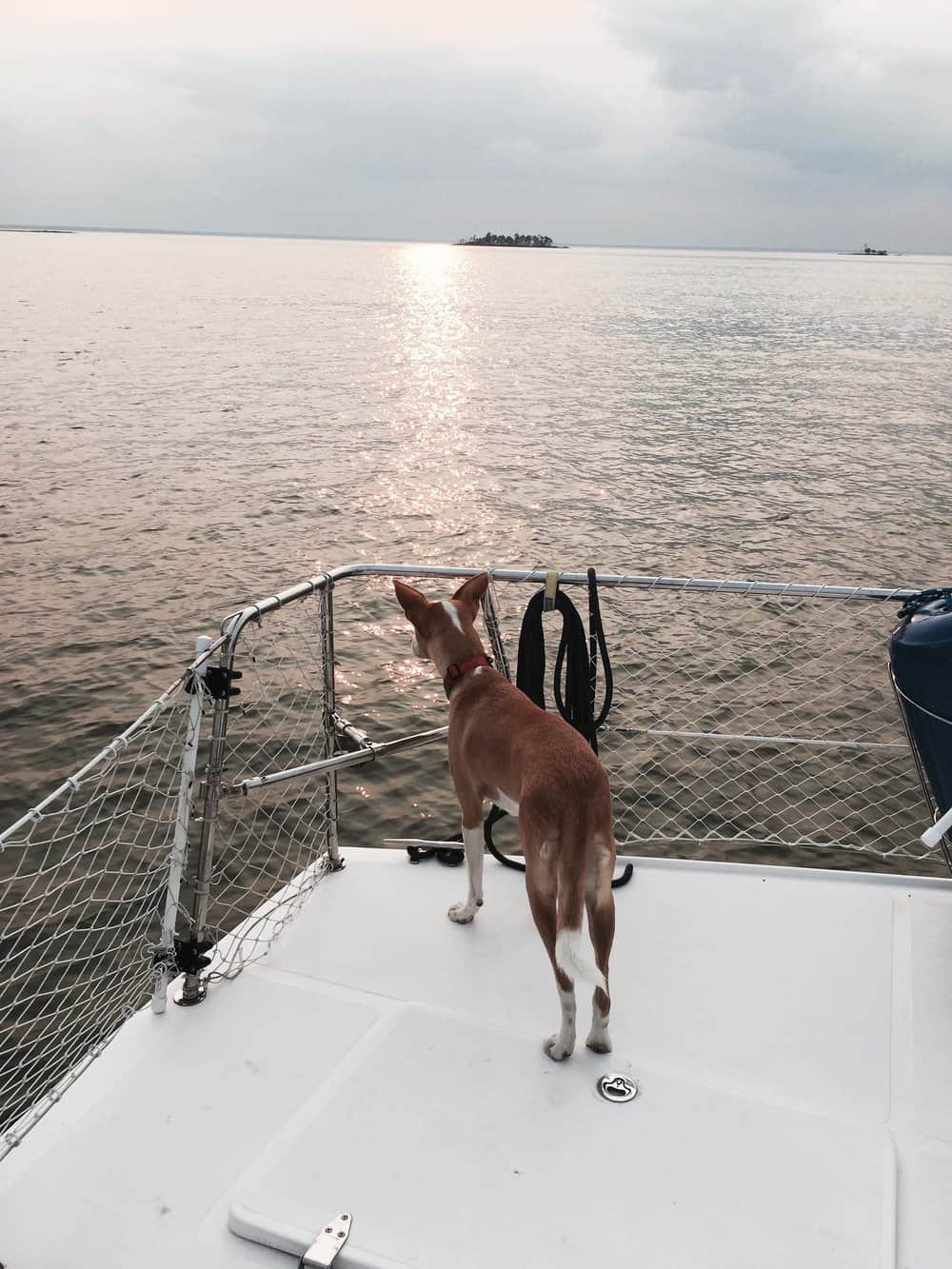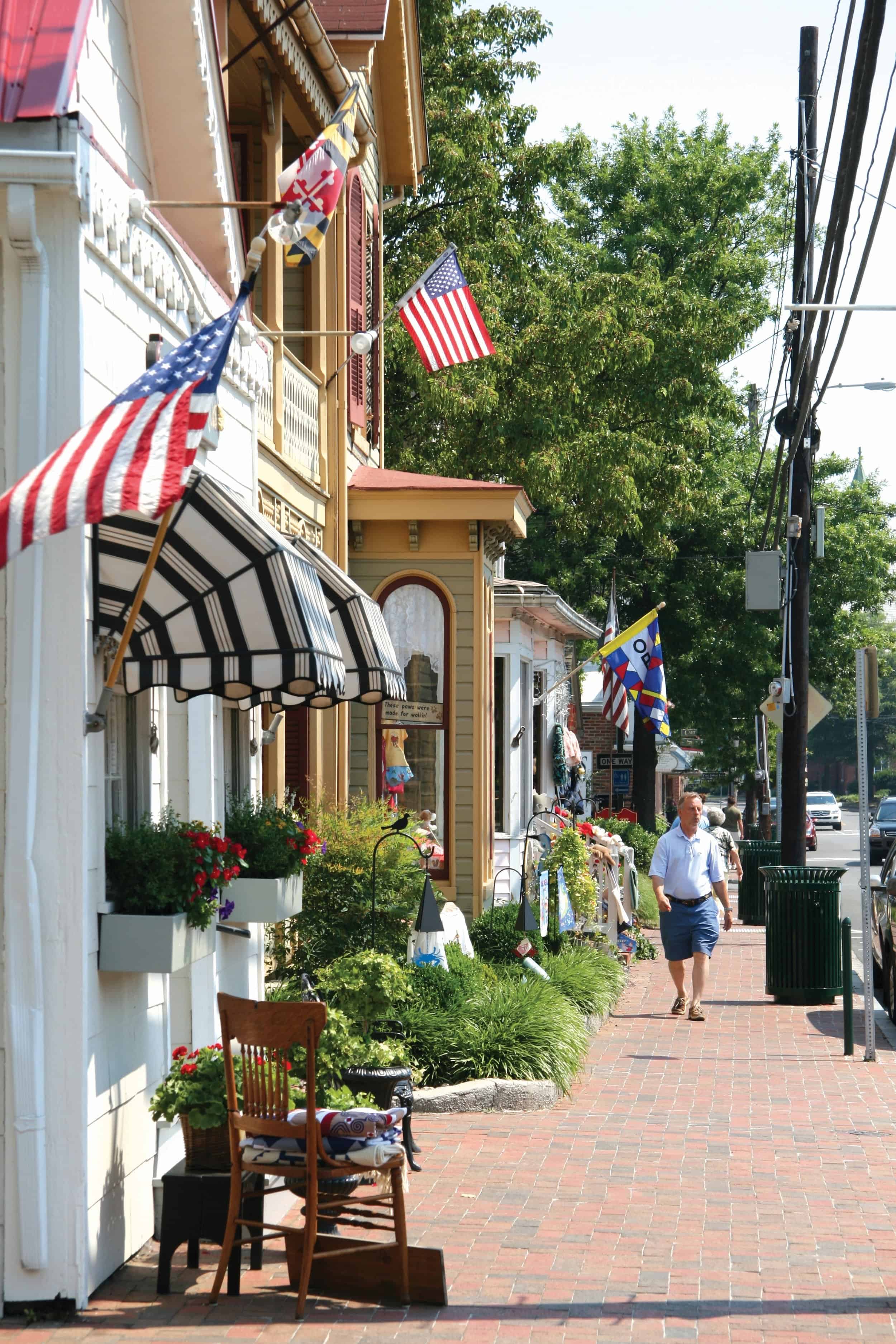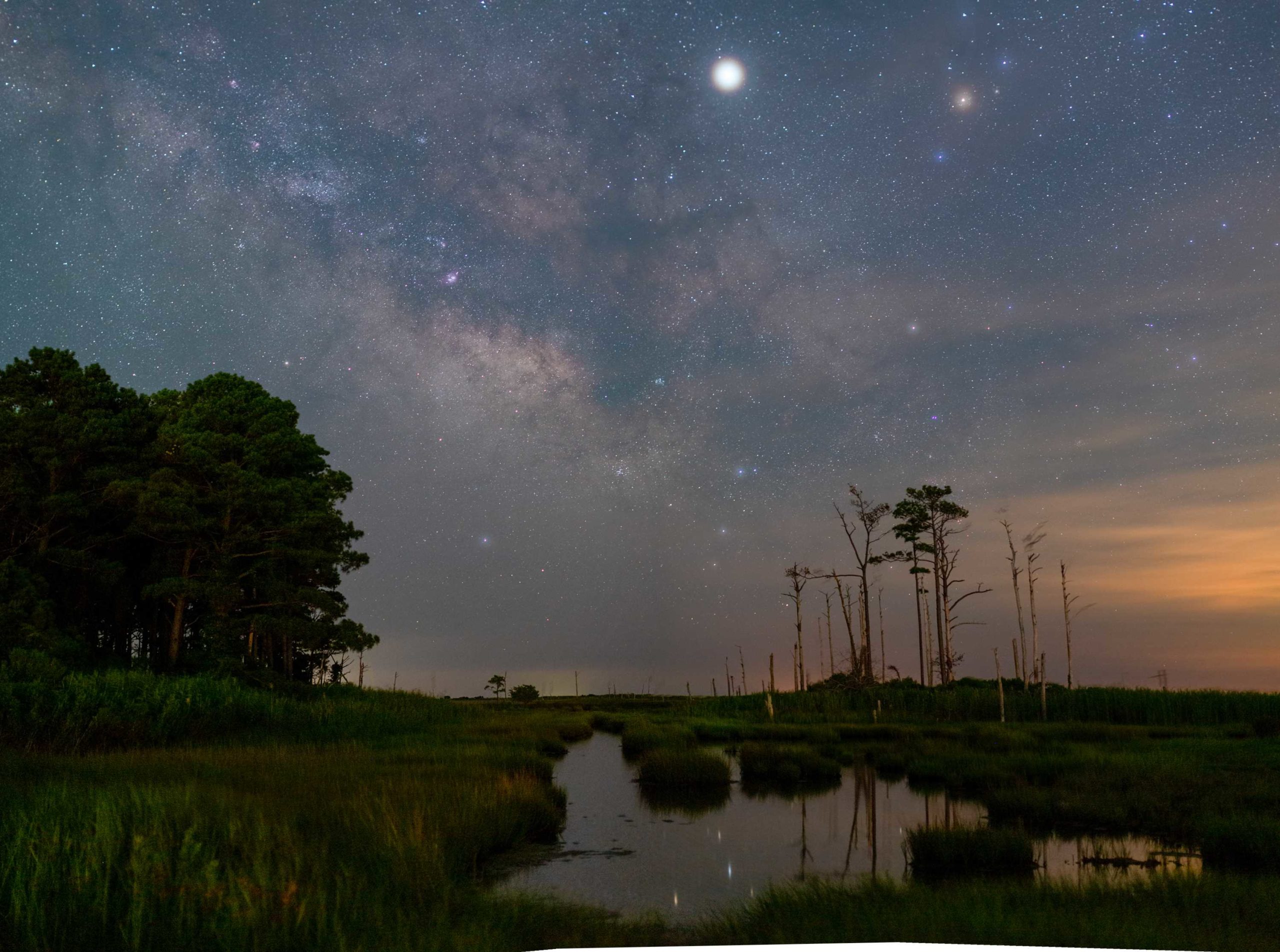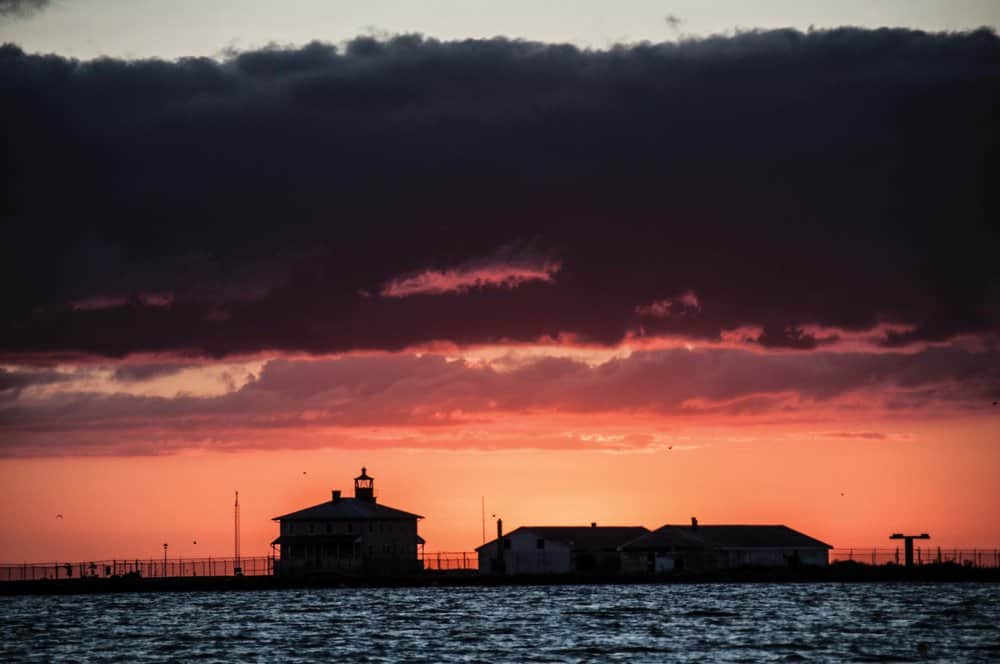Madison Bay is lovely, once the fog clears.
The Little Choptank River has long been the anchovies on my cruising pizza. And I don’t like anchovies.
Here, for example, is my first memory of the Little Choptank River: It’s a breathlessly hot afternoon in high summer in maybe 2005. My boating buddy Hal and I are standing in the cockpit of my old Albin Vega 27 having a “discussion.” Hal is holding up his early Garmin GPS and telling me that Slaughter Creek’s channel lies over that way. I am standing at the tiller holding up my early iPhone with the first generation iNavX app on it and telling Hal that he’s the equivalent of an idiot. “The deeper water lies over there,” I say in a tone that I hope brooks no argument.
We had left Point Lookout on the Potomac before dawn that morning, heading for somewhere entirely different—Crisfield, I think—but for various reasons ended up here on the Little Choptank instead, tired, cranky and in 3 feet 11 inches of water. We draw 3 feet 10. It’s a tricky moment.
As we stand there weighing our options like two five-year-olds, a large fishing boat shoulders past us, anxious to be home. Immediately we give chase and run aground. Well, you don’t want to hear the rest of the story, and I don’t want to tell it. Suffice it to say that Hal and I didn’t speak for a month.
After that, my relationship with the Little Choptank failed to improve. A few years later, for example, venturing into the Little Choptank on an Albin 28, the ship’s dog Skipper and I were suddenly and treacherously boarded by a plague of horse flies. All that day, those pestilential insects hounded us upriver and downriver and into every one of its tributaries. As soon as we had made a dent in the population, reinforcements arrived. I forget what we did in the end, but I wrote about it in this magazine, so you can look it up if you’re curious.
And that wasn’t the end of it. There was the great midge epidemic of 2007 and the three-day fog on Madison Bay in 2010, which was accompanied by whatever is the opposite of a king tide so I couldn’t even get out.
“Then why did you keep coming back?” you ask, a little exasperated at this point.
Two reasons. One is that people of my acquaintance regularly raved about the Little Choptank’s lovely and quiet anchorages. “Bugs?” they would say. “We never see bugs.”
The second reason is that the Little Choptank is located in a handy place, particularly if you are going up or down the Bay and you don’t want to go into Solomons. Now Solomons is a lovely place, but if you are just using it as a Days Inn or a Marriott, it doesn’t matter how nice it is, it’s still miles off the interstate. Of course, so is the Little Choptank, but it’s a little farther along northbound and a little sooner southbound. Anyway, like Baby Bear’s bed, it feels as if it’s going to be just right.
Which is why, over the years, I kept getting anchovies on my pizza.
That is, until a few years ago, when my Little Choptank luck underwent a sudden change. On a late fall afternoon in 2014, my husband, Rick, and I, along with ship’s puppy Bindi, dropped anchor behind James Island, which you get to from inside the Little Choptank. I held my breath. But nothing bad happened.
The anchorage behind James Island, if you don’t know it, is a good one, especially if you are delusional. It works like this: You pretend that the island will protect you from a south wind or a west wind, but of course it won’t do any such thing. It rises maybe six inches above the water and is steadily losing what little ground it has. You might as well anchor behind a telephone pole, except the telephone pole is much taller and only a little skinnier. But it’s the idea that counts, because you will often see a sailboat or two anchored there, playing pretend.
Anyway, on this occasion it was a dead calm night, so it didn’t matter where we anchored. What mattered was that nothing bad happened. As we retrieved the anchor the following morning, I decided that perhaps the Little Choptank’s vendetta against me had begun to fade.

Two years later, I decided to test my hypothesis. This time, grown-up Bindi, puppy trainee Sammy and I ended a long day coming up the Bay by dropping Moment of Zen’s anchor in the first cove inside the Little Choptank’s Fishing Creek, just west of Cherry Point. It was a beautiful spot and required no magical thinking. We were protected from the southwest wind that had been harrying us all day, and it was quiet and bugless. In other words, it was all you could hope for in an anchorage anywhere. I was definitely beginning to like the Little Choptank.
In its short, nine-mile span, the Little Choptank can, in fact, boast of a dozen fair-to-excellent anchorages, as well as a couple of interesting sites, one of which you can get to with a little effort. The other not so much.
First, on Fishing Creek, there is another good anchorage just past Cherry Point that has even better protection than the one I used. Then, beyond that lies Church Creek where you will find site number one, Old Trinity Church (oldtrinity.net). And you really should go see Old Trinity Church someday.
The problem navigationally is that Church Creek channel starts out sufficiently deep, but then shallows quickly. I tried it out on one of my early forays in the Albin 28 and quickly chickened out, but you could anchor in Fishing Creek and simply take the dinghy in. There is even a small dock.
Set among ancient trees and a Jane Austen-perfect churchyard, Old Trinity Church is as decorative as a jewel box, and nearly as small. The church building was constructed in the late 1600s, modified in the 1850s to the then-trendy gothic style and then painstakingly set back to rights in the 1950s. Among those buried in its churchyard are Gov. Thomas Carroll, his quite extraordinary, activist daughter Anna Ella Carroll, and a smattering of Episcopal bishops and soldiers from every war America ever fought.
The idyllic creek, the jewel-box church, and the well-ordered churchyard with its grove of trees older than we can rightly imagine, all make it a moving spot, no matter what your proclivities.
On the north side of my new friend the Little Choptank, there are three anchorages worth noting. Phillips Creek, whose entrance is opposite Fishing Creek, has at least two good anchorages, though you’ll need to be careful to dodge the long shoal off Morris Neck to starboard. (The shoal off Cedar Point to port is marked by green “13”).
There is a second unmarked shoal to be avoided off Cherry Island inside the entrance. You can anchor there off the tip of the shoal, or better still, work your way a little bit further up Phillips Creek’s narrow channel. There you can anchor in peace and quiet, well protected from the east and west.
Alternatively, you can turn to starboard just inside Phillips Creek and enter Beckwith Creek below Cherry Island. Watch the shoal off
the east side of the island, and you’ll find a nice section of six to seven feet and a good and very quiet anchorage. As a bonus, there are several sandy beaches in the area, both here and
up Phillips Creek.
The last anchorage I’m going to mention is up the main branch of the Little Choptank, just before it shallows out. It’s not a great anchorage—it is exposed to chop from the southwest—but it does get you about as close as you are going to come by boat to the
old Spocott Windmill (spocottwindmill.org), which you might enjoy seeing, if not actually visiting.
If you anchor near the mouth of Smith Cove and dinghy inside a bit, you should be able to spot the mill, which was built in 1972 by master boatbuilder Jim Richardson. The original mill was built in 1852 and destroyed by a blizzard in 1888. It’s a single-post mill, which means that the entire building will swing with the wind, which is very cool. The grounds are available to tour anytime, and the mill operates a couple of times a year (next on October 20).
I will end this paean to the lesser among Choptanks with a mention of my most recent experience there. In mid-March of this year I found myself yet again lured inside. I wanted to get north of Solomons because the weather forecast for the following day was fairly grim: small craft warnings in the morning, followed by a gale warning at noon. More fool I.
It was getting late, and I was nervously watching the sun drop quickly behind the horizon as I followed the Little Choptank channel south then east. It was already too windy for even my delusional soul to anchor behind James Island, and I calculated that it would be pitch dark well before I reached Fishing Creek. So, I did what scores of boaters have done before me and took refuge behind Casson Point, a low narrow finger of land at the mouth of Hudson Creek, the second of the Little Choptank’s north-side tributaries.
It’s an easy approach, even after the sun has dropped out of sight—which it had done by the time I got there—and its low, sparsely wooded shore promises three- or four- telephone-poles-worth of protection from the west.
In the dark, I settled Zen about midway between the red and green markers, dropped the anchor and called it a day. The west wind kept at
it all night, but we had just enough protection behind Casson to be moderately comfortable.
As I hauled up the anchor at first light the next day, however, the wind clocked east and picked up. By the time I reached the Bay an hour later, the predicted gale had arrived—six hours early. But that’s another story, and this one is about the Little Choptank River and the the answer to this important question: After all these years, has the Little Choptank finally become the pepperoni on my cruising pizza? Maybe. I’ll let you know in another decade or so. But meanwhile, I believe I’m beginning to like those tiny briny forage fish after all.




